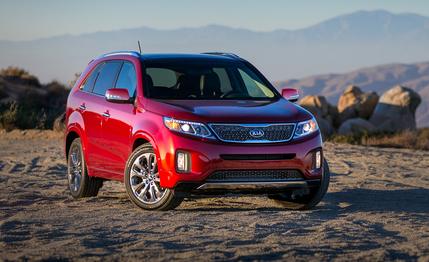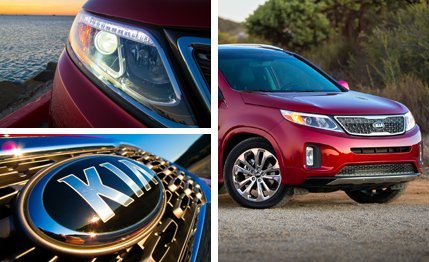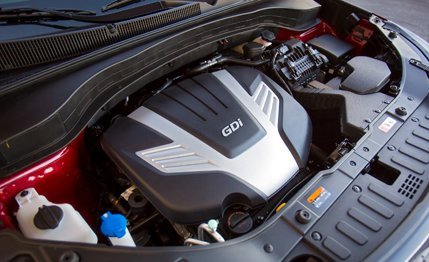
 First Drive Review
First Drive Review
So just where is the semantic boundary between freshening and all-new? The 2014 Sorento crossover comes along at the scheduled time for a mid-cycle refresh, doesn’t look vastly different from its predecessor, and maintains the same 106.3-inch wheelbase (shared, of course, with the five-door Hyundai Santa Fe Sport).
Nevertheless, Kia calls the updated Sorento “80 percent new.” And that includes a new chassis, a new V-6 engine, new interior materials, new telematics, and new infotainment.
At many carmakers, a list of updates such as the above, particularly one that extends to fundamentals such as chassis and powertrain, would be presented as a total redesign. Kia has the grace to refrain from calling the 2014 Sorento all-new, although the marketing troops stressed to us that the word “freshening” definitely lacks bandwidth in this application.


Foundations
Although the wheelbase is unchanged, the modestly restyled body shell (with revised front and rear fascias) has been extensively reengineered, with a new subframe supporting the front suspension, a new strut-tower brace, and a greater percentage of high-strength steel. The result, claim the engineers, is an 18-percent improvement in torsional rigidity.
The track has been widened slightly, lending a more action-ready look to the Sorento’s stance, the multilink rear suspension utilizes new bushings and mounts, and the spring rates and the shock absorbers have been revised to enhance steering response. The electric power-steering system is new and standard on all models; Flex Steer (standard on SX and SX-L models) provides three driver-selectable settings—Comfort, Normal, and Sport—that vary effort.
Powering Up
Under the hood, last year’s mid-level direct-injection 2.4-liter four is the new base engine; it offers 191 horsepower and 181 lb-ft of torque. (The previous model’s port-injection 175-hp 2.4-liter has been cast aside.) At the top of the Sorento hierarchy, last year’s optional port-injection 272-hp, 3.5-liter V-6 gets the heave-ho, replaced by a 3.3-liter direct-injection V-6. An oversquare design with a lofty 11.5:1 compression ratio, the new 3.3-liter V-6 made its first appearance in the Hyundai Azera sedan and is rated for 290 horsepower and 252 lb-ft of torque.


Both engines are paired with a six-speed automatic transmission that features a straight (as distinct from dogleg) shift gate that makes moving the lever from, say, park to drive, a less joggy affair. The Sorento’s optional all-wheel-drive system has been revised and features a locking center diff plus torque vectoring that complements the stability-control system.
All the foregoing is part of the Santa Fe inventory. However, the upgrade engine in the five-seat Santa Fe Sport, which shares the Sorento’s 106.3-inch wheelbase, is a 264-hp, 2.0-liter four-cylinder turbo. The 3.3-liter V-6 is reserved for the long-wheelbase, seven-seat edition of the Santa Fe. The Sorento is available in five- and seven-passenger seating.
EPA fuel-economy ratings for the four-cylinder Sorento with front-wheel drive are 20 mpg city/26 highway; all-wheel-drive versions ring in at 19/24. Step up to the V-6, and fuel economy is rated at 18/25 with front-wheel drive and 18/24 on all-wheel-drive models. In any case, although it’s characterized as the standard engine, the four is available only in the base LX trim level.
Quietly Competent
Our Sorento driving experience consisted of a late-morning run from Phoenix to Globe, Arizona, on roads that generally lacked challenge or nasty pavement. The test fleet was limited to Sorentos equipped with the V-6 engine. However, the route did involve some substantial elevation changes, and the V-6 had to work hard to generate passing power when altitudes climbed north of 3000 feet.
On the other hand, the V-6 is smooth, something that can also be said for the transmission, and in most operating conditions the powerplant is a pleasant traveling companion. Moving up from the four-cylinder LX to one with the V-6 does add $1600 to the bottom line, but it doesn’t add much to the fuel bill and makes for a livelier Sorento.